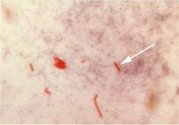PURPOSE: Several publications about tuberculosis in elderly patients have suggested that their clinical presentation and clinical course might be atypical from those in elderly. This tendency may be more strengthened with advancing years in age. The aim of this study was to compare clinical features of pulmonary and pleural tuberculosis in extreme elderly (>80 years old) with those in elderly (between 60 and 79).
METHODS: Thirty-seven extreme elderly with pulmonary and pleural tuberculosis from Ulsan University hospital between January 2000 and December 2004 were compared with randomly selected fifty-six elderly patients.
RESULTS: General weakness was the only symptom that was observed more frequently in extreme elderly than in elderly (p=0.016). Other symptoms such as cough, sputum, fever, weight loss, anorexia and chest pain were not different between two groups. Dyspnea tends to be more frequent, and hemoptysis tends to be less common in extreme elderly although they were not statistically significant (p=0.056, 0.053 respectively). Evolution time before diagnosis and laboratory findings at presentation were not different between two groups. The incidence of comorbid conditions such as chronic obstructive pulmonary disease, diabetes, gastrectomy and malignancies were not different between two groups. Anorexia was more frequently observed in extreme elderly than elderly after initiation of antituberculous drugs. The incidences of hepatotoxicity, skin rash, optic neuritis and peripheral neuropathy were not different. Moreover, the mortality from tuberculosis was not different between two groups. Three cases died from tuberculosis in extreme elderly. The cause of death for those three cases was mainly discontinuation of antituberculous drug.
CONCLUSION: The clinical features and prognosis of pulmonary and pleural tuberculosis in extreme elderly were not significantly different from those in elderly.
CLINICAL IMPLICATIONS: Tuberculosis even in extreme elderly should be treated with standard regimens because adverse effects of antituberculous drugs and prognosis were not different from elderly patients.
DISCLOSURE: Eun A Eum, None.
Eun A Eum MD * Yangjin Jegal MD Moo Cheol Shin MD Kwang Won Seo MD Woon-Jung Kwon MD Jong-Joon Ahn MD Department of Pulmonology and Critical Care Medicine, Ulsan University Hospital, Ulsan, Korea
COPYRIGHT 2005 American College of Chest Physicians
COPYRIGHT 2005 Gale Group



